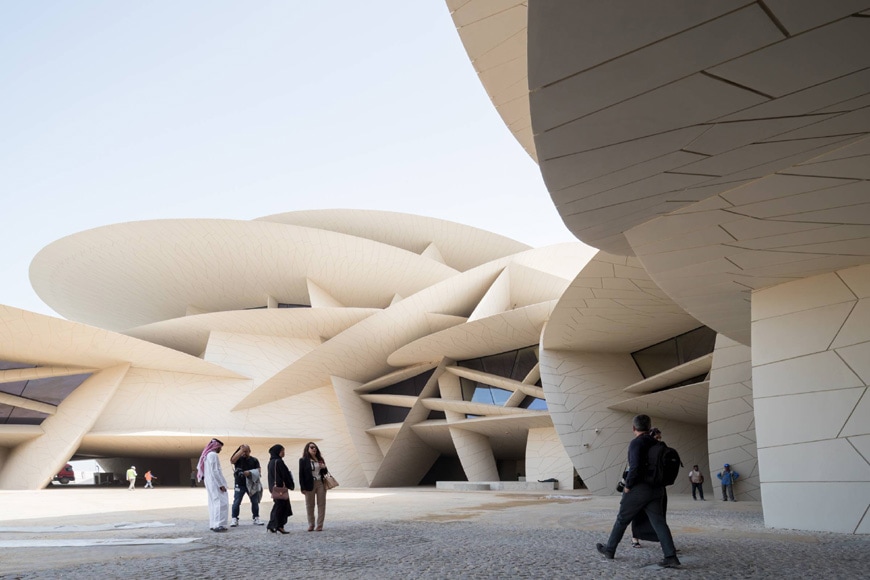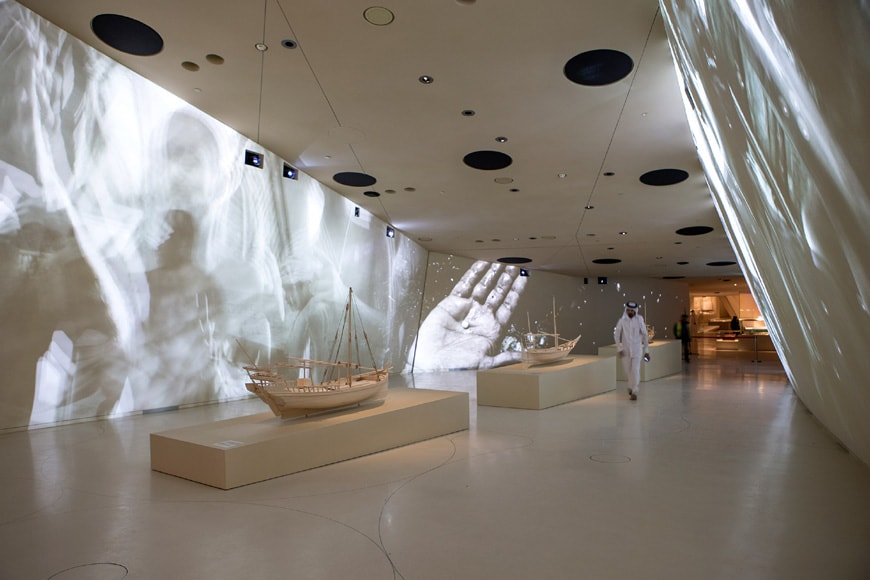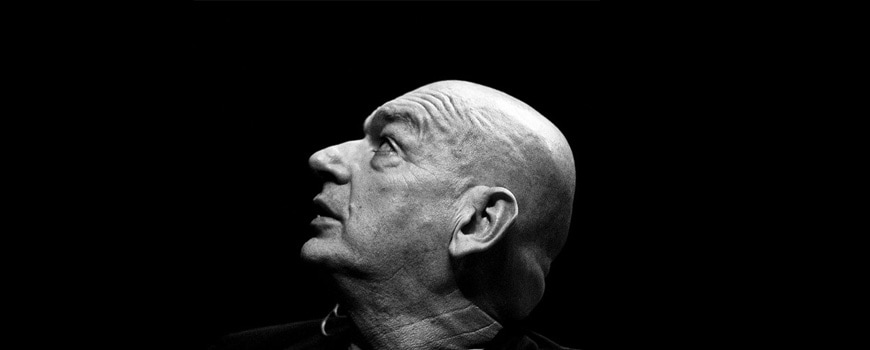National Museum of Qatar, Doha – Jean Nouvel
Ad-Dawhah, Qatar

The National Museum of Qatar in Doha is a museum presenting the history of Qatar housed in an iconic building, nicknamed “The Desert Rose”, designed by French architect Jean Nouvel.
Above: the new National Museum of Qatar designed by Ateliers Jean Nouvel.
History & architecture
Opened on March 28, 2019, the new museum replaces the original Qatar National Museum, founded in 1975 by Emir Khalifa bin Hamad Al Thani to illustrate Qatari history and culture.
The National Museum of Qatar building is a peculiar construction whose shape was designed by Pritzker Prize winner Jean Nouvel to resemble a Desert Rose crystal cluster.
National Museum of Qatar, aerial view; photo Iwan Baan; courtesy of National Museum of Qatar.
The 430,000-square-foot / 52,000-square-meter museum consists of several disc-shaped volumes interconnected to one another to form a 350-meter-long loop-shaped architectural complex.
Made up of a steel frame clad in fiber-reinforced concrete, the disks were designed to provide plenty of shading in the notoriously torrid climate of the Qatari peninsula, along with being a reference to the desertic landscape of the country.
The complex also includes the Royal Palace of Sheikh Abdullah bin Jassim Al Thani, a 20th-century historical building that was preserved and restored.
Along with exhibition areas, the museum contains a 213-seat auditorium, learning spaces, a research center, two shops, two cafes, a rooftop restaurant, and a park with a botanical garden, a sculpture garden, an artificial lagoon, a children’s playground, and various amenities.
A view of the museum complex from the courtyard; photo Iwan Baan.
Plan of the museum; image courtesy of National Museum of Qatar.
The new building and, on the right, the historic Royal Palace of Sheikh Abdullah bin Jassim Al Thani; photo Iwan Baan.
A close-up of the building’s fiber-reinforced concrete cladding; photo Iwan Baan.
As previously mentioned, the museum also contains two shops, a book and gift shop and a children’s gift shop, installed in cavernous wooden spaces, designed by Australian architecture firm Koichi Takada Architects, whose forms were inspired by the Dahl Al Misfir (Cave of Light) cave in central Qatar.
Replicating the connection between natural forms and architecture of Nouvel’s building, the shops were realized using 40,000 pieces of CNC-cut solid oak wood assembled on-site by Italian company Devoto Design to create a surprising canyon-like space.
Permanent exhibition
Internally, the museum contains a 1.5-kilometer-long loop path that encircles a central courtyard, called Howsh in the Arabian language.
The permanent exhibition unfolds along the path throughout a sequence of eleven interlocked galleries to present the history of Qatar by the means of about 8,000 objects – archaeological artifacts, artworks, textiles and garments, objects of decorative and applied arts, boats, machinery, jewels, books, natural history specimens, and historical documents – as well as through audiovisuals and interactive installations.
The famous Pearl Carpet of Baroda – a late 18th-century Indian carpet embroidered with over one million pearls together with emeralds, sapphires, and diamonds – is certainly one of the most impressive pieces on view.
The Pearl Carpet of Baroda pearl-and-gem-embroidered carpet; photo Danica O. Kus.
The exhibition is divided into three thematic areas called chapters – Beginnings, Life in Qatar, and The Modern History of Qatar – which depict chronologically the history of the country from prehistory to the present day, with a special focus on its natural environment, long maritime tradition, artistic heritage, postwar industrial development, and future development programs.
“The building I designed needed to reflect these three different stories. The first, which covers a long period, is the story of the peninsula and its inhabitants. The second is an exploration of the coastal and desert lifestyles as well as the pearling industry, and the third covers the spectacular acceleration that gave the kingdom – in just a few decades – the power and prosperity we associate with it today. Because of its economic power, Qatar has become a world leader in fields as diverse as education, communications, and energy technology.
The desert rose, a flower-like aggregate of mineral crystals occurring only in arid coastal regions, is the first architectural structure that nature itself creates, through wind, sea spray, and sand acting together over millennia. It’s surprisingly complex and poetic.” Jean Nouvel
The permanent exhibition “chapters” are organized as follows:
Chapter 1 – Beginnings contains three galleries: The Formation of Qatar, Qatar’s Natural Environments, and The Archaeology of Qatar
Chapter 2 – The Life in Qatar comprises four galleries: The People of Qatar, Life in Al Barr (Desert), Life on the Coast, and Pearls and Celebrations.
Chapter 3 – The Modern History of Qatar contains four galleries, the first gallery presents the history of the country from 1500 to 1913, the second gallery covers the period 1913-1972, the third gallery covers the period 1972-2013, and the fourth gallery, entitled Qatar Today, presents the country’s recent history and immediate future.
National Museum of Qatar, interior views of the permanent exhibition galleries; photos Danica O. Kus.
All images are courtesy of the National Museum of Qatar.
How our readers rate this museum (you can vote)
copyright Inexhibit 2024 - ISSN: 2283-5474












 (8 votes, average: 4.38 out of 5)
(8 votes, average: 4.38 out of 5)
